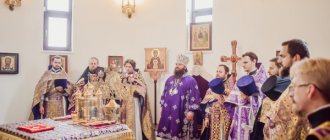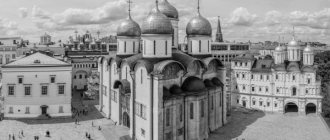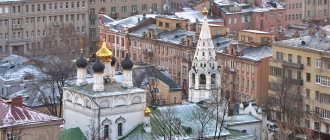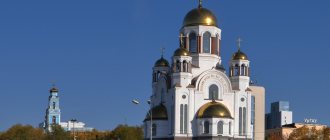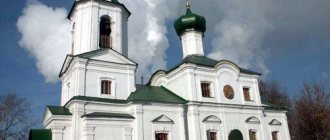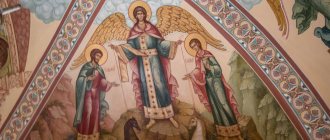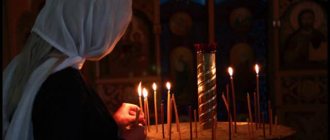In Nizhny Novgorod, famous for its Orthodox history and religious heritage, a large number of holy monuments have been preserved. The Temple of the All-Merciful Savior is one of these buildings; it is often called a thriving center of local Christianity.
The cathedral was founded in honor of the rescue of the imperial family of Alexander III when a train derailed. The miracle was associated with the fact that the sovereign had with him an ancient image of the Savior Not Made by Hands.
Church in the name of the Most Merciful Savior in Nizhny Novgorod
Church history
The reason for the appearance of the temple was the miraculous rescue of members of the royal family, which occurred in 1888 during the crash of the imperial train.
The train accident happened on October 17, when Alexander III and his relatives were returning from
Crimea
to
St. Petersburg
. While on the move, at a speed of about 68 km/h, 10 carriages of the train derailed, and only 5 carriages remained intact. In total, 21 people died and many were injured in the horrific crash.
View of the church from Maxim Gorky Street
The carriage in which the imperial family was traveling was completely destroyed, but the king himself, his relatives and those accompanying them were not injured. This was regarded by many in Russia as a miracle and God's providence. Therefore, near the site of the accident - near the Borki station not far from Kharkov, as well as in various other parts of the country, they began to build churches in gratitude for the salvation of the sovereign.
It is known that Alexander III had with him a copy of the icon of the Savior Not Made by Hands, made from an ancient miraculous image located in Vologda. Therefore, in the city, on the initiative of the Nizhny Novgorod Duma, it was decided to build a church dedicated to the All-Merciful Savior.
In order for this temple to appear, funds were needed. And to collect donations, a construction commission was created in the city. According to tradition, the main patrons of the new church were wealthy merchants and industrialists - grain industrialist and financier Nikolai Aleksandrovich Bugrov; owner of Nizhny Novgorod mills, elevators and steamships Nikolai Emelyanovich Bashkirov; as well as merchants and philanthropists Aristarkh Andreevich Blinov, Alexey Maksimovich Gubin and Vasily Alekseevich Sobolev.
View of the church bell tower and the main entrance to the temple
In 1897, when the bulk of the funds had been collected, the construction commission held a design competition, in which members of the Imperial Society of Architects of St. Petersburg participated. Of the 18 works presented, Nizhny Novgorod residents most liked the project prepared by the famous architect and academician Alexander Mstislavovich Kochetov. He had extensive experience, and, in addition to Nizhny Novgorod, built buildings in Kostroma
, Mineralnye Vody and Sevastopol.
At the turn of the 19th and 20th centuries, it was fashionable to build new churches in the pseudo-Russian style, using architectural techniques of pre-Petrine architecture. Therefore, as a model for the future church, Kochetov chose the Church of the Life-Giving Trinity in the Moscow estate of the Sheremetyevs - Ostankino
, built in the 70-80s of the 18th century.
The Nizhny Novgorod church was founded in 1899, choosing a place for its construction not far from the city fort - at the intersection of Ostrozhnaya and Spasskaya streets.
At the turn of the 19th and 20th centuries, it was a newly populated outskirts of Nizhny Novgorod, where there was no own parish church at that time.
The laying of foundation stones for churches in Russia was always solemn and looked like big holidays. The first stones in the foundation of the future Church of the Savior were laid by Bishop Vladimir of Nizhny Novgorod and Arzamas, the governor and city mayor of Nizhny Novgorod, members of the construction commission who collected money for the temple, as well as members of the city Duma.
Construction lasted until the autumn of 1903 and took place under the technical supervision of academician of architecture Vladimir Petrovich Tseydler.
Finally, all the bells were raised to the temple bell tower, gilded crosses were installed on the domes, and the temple was consecrated.
View of the church from Belinsky Street
It turned out to be quite spacious and could accommodate 1,700 parishioners. The inventory of the temple property, made before the 1917 revolution, notes that there were 8 bells in the Spasskaya Church, and the largest of them weighed more than 2.5 tons. 7 bells were cast for this church by Yaroslavl craftsmen, and one bell was donated by an unknown Nizhny Novgorod resident.
In 1912, the church was painted by masters led by Nizhny Novgorod artist and photographer Andrei Osipovich Karelin.
They completed wall frescoes, taking as a model the works of famous Russian painters in the Cathedral of Christ the Savior and Vladimir Cathedral in Kyiv. And the ornamental painting was done in the neo-Byzantine style, using sketches by A. M. Kochetov.
After the arrival of Soviet power, the Spassky Church remained operational for some time. In the early 1920s, it even housed a bishop's see, headed at that time by Metropolitan Sergius (Starogorodsky). Then anti-religious sentiments in the state intensified, and in 1930 they tried to close the church. The city authorities made this decision after a collective appeal from citizens with a request to suspend the work of the temple. But the members of the parish council and the rector of the church, Archpriest Fr. Nikolai (Bogolyubov) managed to challenge this resolution of the city authorities with the leadership of the All-Union Central Executive Committee in Moscow
.
True, the Nizhny Novgorod authorities “conquered” part of the basement of the Spasskaya Church and began to use it for the warehouse of the city Red Cross Society. There, in the basement, lived members of the families of the church clergy - the rector of the temple, his wife and their children. However, in November 1937 the temple was closed, and three of its priests were arrested.
View of the north-eastern façade of the church
In subsequent years, Nizhny Novgorod authorities developed a plan to remodel church premises for city needs. At first they wanted to demolish the domes and tent on the bell tower. But due to a number of accidents, this did not happen, and only the temple interiors, which were adapted for archival storage, were altered. This happened before the Great Patriotic War. During the war, the bell tower housed one of the city's air defense points, and there was an anti-aircraft installation here. Old-timers remember that during the bombing, explosions occurred in the immediate vicinity of the temple, but the temple itself was never damaged.
In 1947, when the state’s attitude towards the Church became more loyal, a group of residents of the then Zhdanovsky district of the city asked to open a church. But the Nizhny Novgorod City Executive Committee refused them, and until the mid-1960s, archives continued to be stored inside the church.
Believers were given the opportunity to return to the temple in 1991. The Church of the Savior was consecrated again and the first service was held here. In recent years, large-scale restoration work has taken place here.
Clear[ | ]
Before the closure of the temple in 1937, it served:
Nizhny Novgorod bishops:
- Bishop Vladimir (Nikolsky);
- Bishop Nazariy (Kirillov);
- Metropolitan Sergius (Stragorodsky) (since 1943 - Patriarch of Moscow and All Rus').
Sign on the temple.
Consecrated on September 6, 1998. Priests[3]:
- 1903-1906 - Archpriest Alexander Troitsky (first rector);
- 1903-1919 - Deacon Mitrofan Taskin (first deacon);
- 1906-1911 - Archpriest Nikolai Roslyakov (since 1907 - rector);
- 1910-1921 - priest Alexander Strelnikov (second priest);
- 1915-1921 - Archpriest Vladimir Sergievsky (since 1916 - rector);
- 1913-1935 - Deacon Dmitry Obodov (until 1922 - psalm-reader);
- 1920-1921 - Deacon John Avrov;
- 1921-1925 - Archpriest Pavel Almazov;
- 1925-1928, 1931-1934[4][5] - Archpriest Nikolai Bogolyubov;
- 1935-1937 - Archpriest John Runovsky (second priest);
- 1930-1937 - Archpriest Nikolai Vinogradov;
- 1934-1937 - Hieromartyr Archpriest Pyotr Sakharovsky (second priest)[6];
- 1922-1937 - Protodeacon Nikolai Savkin.
The architecture of the temple and its interior decoration
Thanks to the participation of several talented architects in its design and construction, the Spasskaya Church turned out to be very harmonious and beautiful. It remains a successful example of stylization in the traditions of Moscow temple architecture of the 18th century.
The red brick church has five domes and a tiered hipped bell tower. It is richly decorated on the facades with high-quality figured brickwork in the Russian patterned style. Some decorative elements imitating white limestone are made using plaster. A new carved iconostasis has been installed inside the church, and the main altar of the temple has been fully equipped.
Church domes
Current state of the church and visiting hours
The Orthodox Church is active and open to everyone. Divine services are held here daily. The church has three chapels consecrated, and patronal feasts are celebrated on May 22, August 29, October 18 and December 19.
Particularly revered temple shrines are the miraculous icon of St. Paraskeva Friday, as well as the icons of Our Lady of the Sign and the All-Merciful Savior. In addition, this church houses an Orthodox cross brought from Jerusalem and particles of the relics of Christian saints.
Since 1997, a Sunday school has been running at the Spassky Church for the children of parishioners, and an Orthodox lecture hall has also been opened for adult parishioners under the “Liturgics” and “Gospel Readings” programs.
Notes[ | ]
- ↑ 1 2
Monasteries and churches of Nizhny Novgorod. - N. Novgorod: Glagol, 2008. - P. 74-77. - Information about this is posted inside the temple itself.
- Degteva O.V.
Church of the All-Merciful Savior in Nizhny Novgorod / Ponomarev Igor, archpriest. - Nizhny Novgorod: Publishing house. dept. Nizhny Novgorod diocese at the Ascension Pechersky Monastery, 2010. - P. 104-169. — 224 p. — ISBN 978-5-903657-19-3. - Stoyukhina N.Yu.
Theologian, philosopher and psychologist Archpriest Nikolai Mikhailovich Bogolyubov: fate and creativity (Russian) // Proceedings of the Nizhny Novgorod Theological Seminary: Collection of works of teachers and students. - 2016. - No. 14. - P. 69-162. — ISSN 978-5-904720-18-6. - UFSB archive. D.2-10837 Quoted from the site: Orthodoxy > Russian Orthodoxy: Orthodox spiritual warriors.
- Invincible. How descendants preserve the memory of a executed priest (Russian) // Vedomosti of the Nizhny Novgorod Metropolis: newspaper. — 2019. — November (No. 22(178)). — P. 17.
- Degteva O.V.
Church of the All-Merciful Savior in Nizhny Novgorod / Ponomarev Igor, archpriest. - Nizhny Novgorod: Publishing house. dept. Nizhny Novgorod diocese at the Ascension Pechersky Monastery, 2010. - P. 188. - 224 p. — ISBN 978-5-903657-19-3. - The publishing department of the diocese published the book “Church of the All-Merciful Savior in Nizhny Novgorod”
How to get there
The Church of the Savior is often called the temple on Poltavka. It is located in the Nizhny Novgorod district of the city, in house 177A on Gorky Street (on the corner of Gorky and Trudovaya). You can get here by trams, buses and minibuses (stops “Poltavskaya Street”, “Belinskogo Street” and “TD Chocolate”). Or walk from the Gorkovskaya metro station (1.9 km).
Attraction rating:
Rating 4.67 [3 vote(s)]
| ← N.NOVGOROD | NIZHNY NOVGOROD REGION Cathedrals of Nizhny Novgorod | RUSSIA → |
Current activity
The church today operates as usual and hospitably opens its doors to believers. Services are held here every day from early morning to eight in the evening.
Important! Currently, the Nizhny Novgorod church on Poltavka holds traditional services and serves as a Christian education center for urban youth.
An Orthodox school is organized here, where children are taught to live in virtue and read the Holy Scriptures. They also teach fine arts and music. The temple hosts a summer camp and organizes pilgrimages.
Divine service in the Church of the Most Merciful Savior
Church ministers are currently actively attracting young people to the righteous path, using the media and social networks everywhere. The rector gave his blessing for the creation of a Christian youth center. From now on, residents of Nizhny Novgorod have the opportunity to visit the Spassky Church and enjoy communication with the Almighty.
